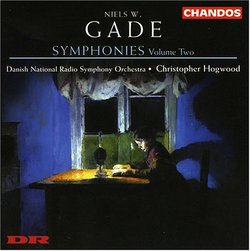| All Artists: Niels Gade, Christopher Hogwood, Danish National Radio Symphony Orchestra Title: Gade - Symphonies, Volume Two / Danish National Radio SO · Hogwood Members Wishing: 1 Total Copies: 0 Label: Chandos Original Release Date: 1/1/2001 Re-Release Date: 11/20/2001 Genre: Classical Style: Symphonies Number of Discs: 1 SwapaCD Credits: 1 UPC: 095115995723 |
Search - Niels Gade, Christopher Hogwood, Danish National Radio Symphony Orchestra :: Gade - Symphonies, Volume Two / Danish National Radio SO · Hogwood
 | Niels Gade, Christopher Hogwood, Danish National Radio Symphony Orchestra Gade - Symphonies, Volume Two / Danish National Radio SO · Hogwood Genre: Classical
|
Larger Image |
CD Details |
CD ReviewsMaking the Best Case for Niels Gade M. C. Passarella | Lawrenceville, GA | 08/18/2005 (5 out of 5 stars) "Niels W. Gade is one of those creative folk who start at the very top of their games. And as far as I'm concerned, he could never quite recapture the amazing assurance of the First Symphony with its wonderfully propulsive last movement. Luckily, though, Gade didn't progress to the very bottom, as Louis Spohr did in his symphonic career: the Danish composer's last two symphonies show a definite maturity, a willingness and ability to change with the times and adopt new trends, despite an abiding conservatism. That's evident in the Seventh Symphony, one of the most popular in Gade's lifetime. Its fresh-air first movement immediately marks it as a pastoral symphony, and in fact it seems to look forward to Raff's bucolic gestures in symphonies such as the Third, subtitled "In the Forest," and even to Brahms's "pastoral symphony," his Third, written almost twenty years later. The last movement of Gade's Seventh is more Schumannesque than Brahmsian, however, and has about it a more earthy quality (shades of the Rhenish Symphony). This is hearty, jolly music. The outer movements provide nice contrast, too, to the somber slow movement and the dancing scherzo complemented by a pair of sober-sided trios. Altogether, a very appealing symphony. The Fourth is a little less so, maybe, but it still has a number of charms. I'm especially partial to the second-movement Andante with its brass fanfares and processional gait, sounding like orchestral music out of some early Wagner opera. The scherzo has clear Mendelssohnian overtones but isn't the worse for that. Its playful mix of sun and shade is quite effective. Compared to the two symphonies, the Concert Overture No. 3 is fairly routine, not at all as memorable as Gade's first overture, "Echoes of Ossian." But it's a pleasant enough affair and a decent makeweight, bringing the disc to a respectable 64 minutes 32 seconds total time. Christopher Hogwood's performances are simply the best I've heard: well paced, lively, brightly colored, showing Gade's expert orchestration to best advantage. The playing from the Danish National Radio is very fine as well, and the recording is everything it should be. Balances are perfect: string tone is lush, yet the brass and the all-important timpani cut through the orchestral fabric just as Hogwood, with his early-music-attuned ear for balances, clearly wants them to." Great Danish music. L. Riffel | San Pedro, CA | 07/01/2003 (5 out of 5 stars) "Just a quick correction to the previous review: Gade is Danish, not Dutch. His music is wonderful. True Romantic style, evoking Beethoven and Saint Saens. Enjoy." Great Danish music. L. Riffel | San Pedro, CA | 07/02/2003 (5 out of 5 stars) "Small correction to previous review, Niels W.Gade is Danish not Dutch. Otherwise I agree 100%. Great composer, very underrated and sadly almost never performed outside in his native Denmark."
|

 Track Listings (9) - Disc #1
Track Listings (9) - Disc #1